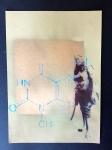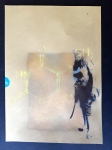The following is an excerpt from my paper, “Empathy of Place” where I condensed some of the ideas surrounding place, memory and identity. These are underlying principles that I consider in my studio practice.
Place, Memory and Identity
Topophilia: “the affective bond between people and place or setting” Yi-Fu Tuan, Topophilia.
Empathy, noun: “The imaginative ascribing to an object, as a natural object or work of art, feelings or attitudes present in oneself: By means of empathy, a great painting becomes a mirror of the self.”
Rootedness
“A human being has roots by virtue of his real, active and natural participation in the life of a community, which preserves in living shape certain particular treasures of the past and certain particular expectations for the future. This participation is a natural one, in the sense that it is automatically brought about by place, conditions of birth, profession and social surroundings.” (Weil 38). The inverse of this is uprootedness, which is manifested through colonialism and industrialization. Acting in resistance to this separation of ourselves and from our relationship to our environment ensures our humanity. Our responsibility to our environment is not extricated from our responsibility to our selves.
“What begins as undifferentiated space becomes place as we get to know it better [through our senses] and endow it with value” (Tuan 6). How do these objects and places then affect our identity as we imbue them with meaning?
Objects as meaning
Jonathan Chapman wrote a book called Emotionally Durable Design and claims that, “we are consumers of meaning, not matter.”. “An important aspect of emotionally durable objects is their ability to ‘be seen by the user to resonate with and be symbolic of the self.” (Chapman 38). As we create art objects, as cultural producers and artists, we are handling meaning as our medium and establishing correlations and relationships between our audience and what we make. “Each person or society forms a unique relationship with objects based upon their individual experiences of the object, ‘where the owner’s personal history in relation to the object plays an important role’.” (Richins 506) These experiences are memories that we tie to the object, establishing it as ‘mnemonic’, and ‘emotionally durable’. (Peters 83).
Landscape as Identity
“While apprehension of our physical environment is shaped by the senses, the meanings that we give, as individuals and communities, to landscapes and places are socially and culturally inflected, and so bound up with complex questions about human identity. If we accept that ‘identity’ is not a given, but constructed in response to an intricate array of social, cultural, economic and physical forces, then how we think of ourselves as individuals, communities and even nations will be shaped by the places and landscapes where we live.” (Lawrence 2). Making and viewing art that acts mnemonically towards this concept of topophilia and place attachment can activate this sense of emotional bond and ultimately resonate with an individual’s identity. W.T.J. Mitchell reminds us that, “landscape is not an object to be seen or a text to be read but a process by which social and subjective identities are formed.” (Mitchell 1).
As it pertains to my work I want to establish that sense of place is important because of how landscape and environment contribute to our identity. The material objects within a landscape remind us of the landscape. By using these objects in art-making we are essentially representing ourselves through them. Ultimately, in regards to cultural production, we subvert the influence of industrialization and colonialism through the assertion of our selves. As we engage with the materials around us relationally, we create work that communicates our identity in ways that we could not using objects and landscapes that have no personal resonance.
Chapman, J. 2005, Emotionally Durable Design: Objects, Experiences and Empathy, London; Virginia: Earthscan.
Lawrence, Kay. “Introduction: Landscape, Place And Identity In Craft And Design.” Craft Plus Design Enquiry 7 (2015): 1-8. Art Full Text (H.W. Wilson). Web. 14 Feb. 2016.
Mitchell W.T.J., 1994, Landscape and Power, Chicago, London: University Of Chicago Press.
Peters, Emma. “The Mnemonic Qualities Of Textiles: Sustaining Lifelong Attachment.” Craft Plus Design Enquiry 6.(2014): 75-94. Art Full Text (H.W. Wilson). Web. 14 Feb. 2016.
Richins, M.L. 1994, ‘Valuing things: The public and private meanings of possessions’. Journal of Consumer Research, vol. 21, no. 3, pp. 504–21, viewed 22 January, http://search.ebscohost.com/login.aspx?direct=true&db=buh&AN=9501161817&site=ehost-live
Tuan, Yi-fu. Topophilia. Upper Saddle River: Prentice Hall, 1974. Print.
Weil, Simone. The Need for Roots; Prelude to a Declaration of Duties toward Mankind. New York: Putnam, 1952. Print.







































 (Students from St. George’s University, after taking Painting 1 from Asher Mains, during their final presentation at the Susan Mains Gallery. All of the students did very well and are ready to contribute to the local art scene. Photo Credit: Asher Mains)
(Students from St. George’s University, after taking Painting 1 from Asher Mains, during their final presentation at the Susan Mains Gallery. All of the students did very well and are ready to contribute to the local art scene. Photo Credit: Asher Mains) (Local artist and recent MFA graduate,
(Local artist and recent MFA graduate, 

















